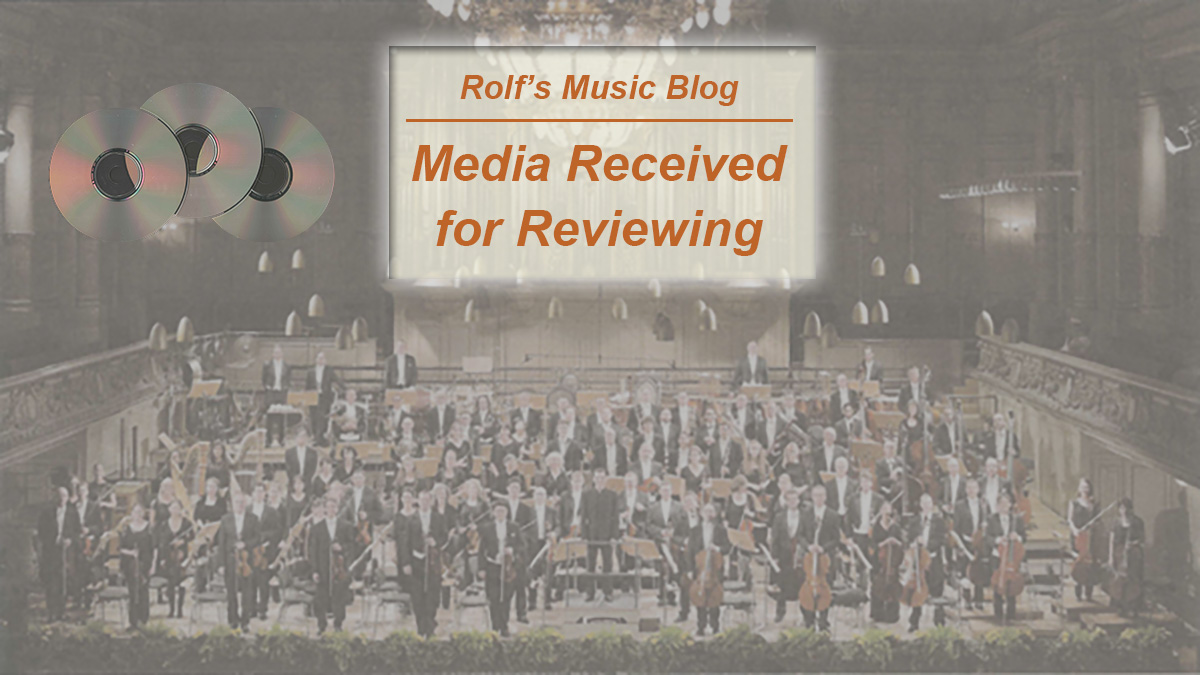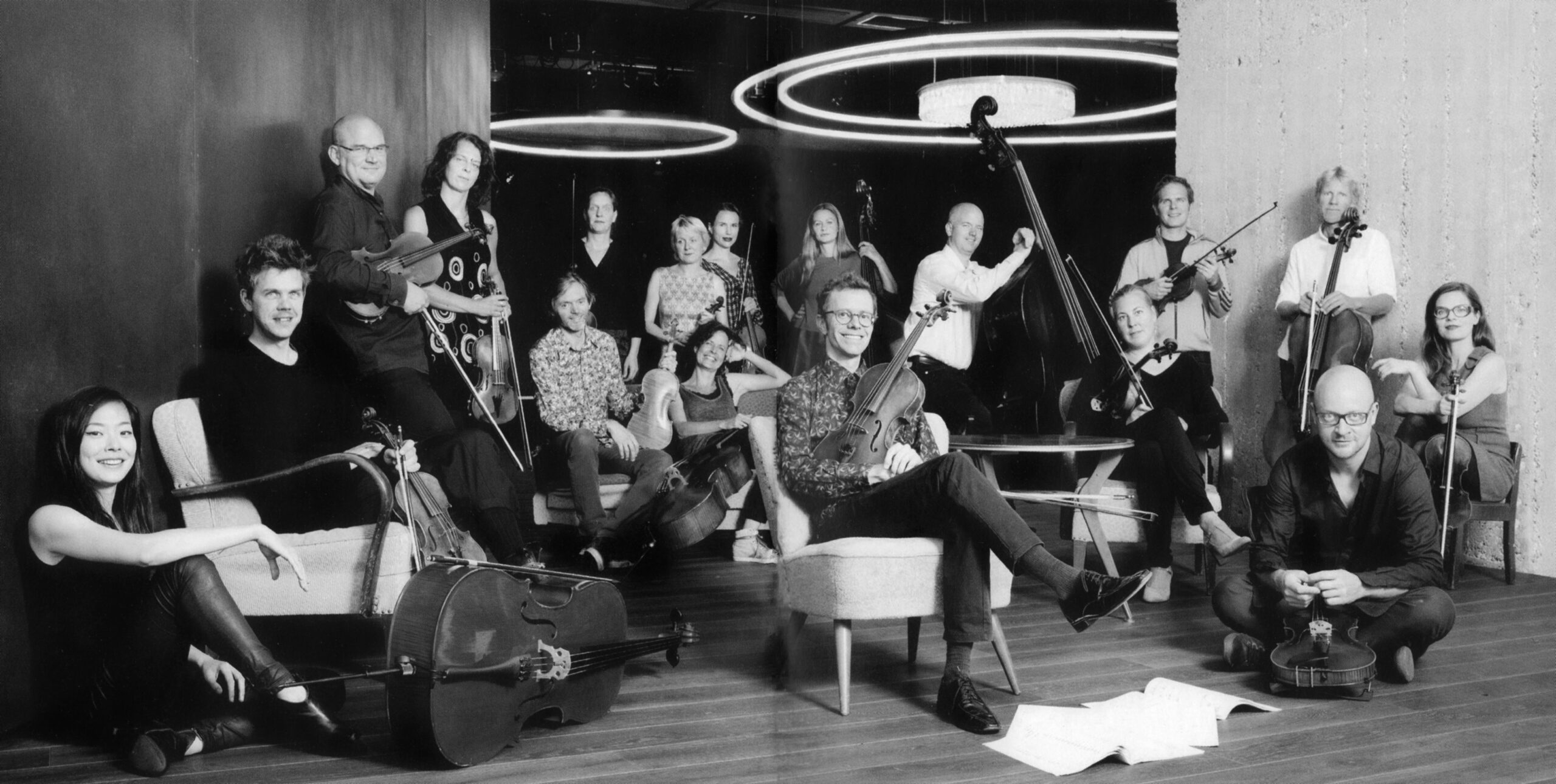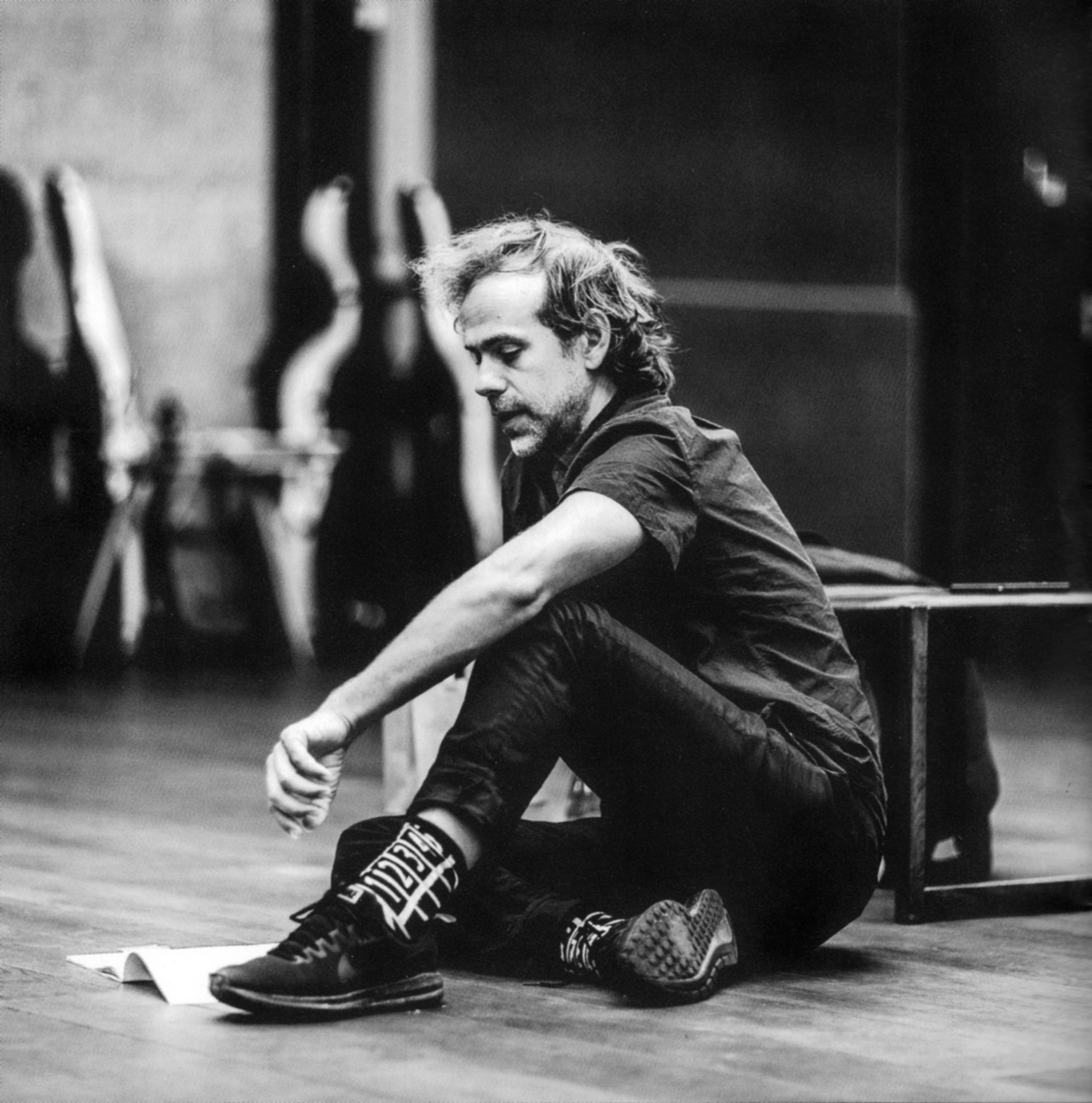Ensemble Resonanz
Bryce Dessner: Tenebre
Media Received for Reviewing

2020-01-18 — Original posting
Table of Contents
Introduction
A couple of months ago, I received the above CD for reviewing. An unusual recording in several ways—certainly in the context of my collection! Already the cover is rather secretive: the text only mentions the composer (Bryce Dessner), the overall title (Tenebre), and the ensemble (Ensemble Resonanz), nothing else. And the cover is entirely black, except for the heavy-duty door lock / handle. That’s a hint towards the recording location, as we will see below.
In fact, it’s a recording entirely devoted to four pieces by one composer, Bryce Dessner. However, it’s equally specific to the artists (Ensemble Resonanz). That group of musicians again is tied to the recording location. It is their “home”, their primary venue for performances. And it is a most unusual location. So, let’s briefly look at the recording venue:
The Recording Venue
There’s a reason for the strange looks of this building: it’s one of four bunkers that were erected in Hamburg 1942 – 1944, during WWII. Two of these bunkers (command centers) were demolished after the war, two others still exist: the one shown above in St.Pauli, another one in Wilhelmsburg. They were both big, autonomous bunkers, as well as aerial defense stations (“Hamburger Flaktürme“). Picture the original state of these towers—without windows! The buildings are among the biggest bunkers ever built: the one above is 75 x 75 m (250 x 250 ft), with a height of 38 m (125 ft.), holding up to 25,000 people during air raids.
The structures are so rugged that their demolition was considered not feasible, with a wall thickness of 4 m (13 ft). Around 1990, the above bunker was changed into a media center, and windows were cut into the walls. There are plans to erect a 5-story hotel onto the top of the tower. So, it is likely that the building will look differently in a few years from now.
One of the facilities in the St.Pauli tower is the Resonanzraum (resonance room), which is the home, the recording location, and the concert venue for the Ensemble Resonanz. The ensemble opened the Resonanzraum in 2014, as Europe’s first “urban chamber music club“. According to the CD booklet, the Resonanzraum combines club atmosphere with outstanding acoustics, creating a “resonance between artists and audiences, as well as [between] different musical eras”.
The door handle on the CD cover may not be “real”, but it clearly stands for the bunker and recording location. And it actually is not untypical for door handles in military / bunker facilities.
The Artists: Ensemble Resonanz
The Ensemble Resonanz, a string orchestra with 18 members, has established itself as one of Europe’s leading chamber music formations. The musicians form a democratic organization: they work without permanent conductor. However, they often perform with prominent soloists, such as the violist Tabea Zimmermann (*1966), the violinist Isabelle Faust (*1972), the cellist Jean-Guihen Queyras (*1967), or the conductor Emilio Pomàrico (*1954). Currently, the violinist and conductor Riccardo Minasi (*1978) is Artist in Residence with the ensemble. Besides giving concerts in their home venue, the Resonanzraum, the ensemble frequently also appears in the Elbphilharmonie, Hamburg’s new concert venue, which opened in 2017.
The ensemble’s repertoire spans from classical up to contemporary music, their concerts also include unusual formats, such as open rehearsals, introductory presentation, even philosophic discussions.
Their Website states that the ensemble consists of 18 string players. The CD envelope, however, lists 22 members: 12 violinists, 4 violists, 4 cellists, and two double bass players.
“Tenebre” (track #2), one of the pieces on the CD, also features a vocal part, which is filled by Moses Sumney (*1991, see also Wikipedia).
Track #3 (“Skrik Trio”) is not for orchestra, but performed by a string trio, consisting of Barbara Bultmann (concertmaster, violin), Tim-Erik Winzer (viola), and Saerom Park (cello).
The Composer: Bryce Dessner
The American composer Bryce Dessner (*1976, see also Wikipedia) is also guitarist and member of the rock band The National. His compositorial oeuvre spans from chamber music to orchestral and vocal works. Compositions were commissioned by notable orchestras, ensembles, and institutions, and he has cooperated with many of the prominent, contemporary composers, such as Steve Reich (*1936) and Philip Glass (*1937), both pioneers of Minimal Music.
Contents & Review
Track Listing
The CD (total duration: 58’41”) features four audio tracks. All four pieces are in one single movement each:
- Aheym (string orchestra; duration 10’22”)
- Tenebre (string orchestra & vocals, sampled; duration: 15’41”)
- Skrik Trio (string trio; duration 18’05”)
- Lachrymae (string orchestra; duration 14’35”)
Track #1: Aheym (2009)
“Aheym” means “homeward” in Yiddish. This is the oldest of compositions in this CD. It was commissioned by the Kronos Quartet. A performance with that ensemble is also found on the composer’s Website.
It’s for good reason that this piece is the first on the CD. It’s the “lead composition”, in a way. Still, it hasn’t been chosen as the overall name for the recording: strong music that instantly sticks to one’s mind!
Listening Experience
One can easily see two main influences / sources of inspiration for this music. The piece opens is a very poignant, rhythmic pattern on a C minor chord that is repeated over and over—as in minimal music. The initial monotonous repetition, the strength of the rhythm to me shows the influence of rock music. However, unlike minimal music, “Aheym” does not work with inconspicuous, gradual changes / alterations. It is clearly not minimal music in the strict sense of the term. Rather, after a number of repetitions, the pattern switches to another chord, then another one, and so on. However, that slow enough for the listener not to get the feeling of a classic harmonic progression. Rather, it’s like changes to a different color. Soon, a second, complementary / contrapuntal rhythm joins in (on a different chord), creating melody fragments, though still based on the initial, strong rhythm.
Suddenly, the pattern stops, and the cellos introduce a second, more melodious pattern / theme, and gradually (initially with pizzicato, later arco, staccato), the other voices inject a complementary rhythm. More voices join in, forming a polyphonic pattern. However, as in rock music, there is not much of a harmonic progression. The alternating harmonies form pattern by themselves.
Around the center of the piece, the initial theme / pattern returns, though now in rough (spiccato, col legno, sul ponticello) articulation. This is followed by a segment where the ostinato pattern (now a short, melodic motif) is in the cello, pizzicato, and the complementary component consists of flageolet (flautando) tones in the high instruments. The final segment seems to marry rhythmic and melodic ostinato, as well as the complementary / contrapuntal principle.
Comments
Several main principles seem to dominate this composition:
- enthralling motoric ostinato rhythms
- rhythmic and melodic complementarity
- contrapuntal rhythmic and melodic pattern
- switching between “colors”
Strong music, for sure, enthralling, fascinating!
Track #2: Tenebre (2010)
Commissioned by the Kronos Quartet and the Barbican (London).
Listening Experience
The piece emerges out of silence. Initially, it just features whirring tremolos, static, simple intervals / chords. Gradually, the voices with movement add in, alternating between tones, then forming chorale-like melodies, picking up volume and urgency. Suddenly, at the culmination, that segment breaks off, the violins take over with a rhythmic, rapid & virtuosic figure, challenging in the coordination. This was conceived as a composition for string quartet, after all! That repeated figure appears to originate from minimal music; it persists, while the other voices slowly add in harmonies in the form of chords in whirring tremolo, that within itself gradually picks up shape and rhythm, forming melodies, while the virtuosic motif moves into the background, later gaining prominence again.
The composition culminates in dense polyphony, then switches to a solemn, chorale-like segment, the rapid movements come and go in parallel. A next segment is inspired by baroque polyphony. It’s a kind of fugue that grows in intensity and density of the texture. When that ends, flautanto / flageolet tones rise above a pizzicato accompaniment. The latter ends, and ethereal tones forming slowly progressing harmonies strongly remind of music by Arvo Pärt (*1935). Here, for the final segment only, the voice (Moses Sumney) sets in. First, this takes the form of vocalises, single falsetto tones, evolving into shoth, ornamented fragments. These are mixed with looped samples of the same voice (baritone and falsetto), rapidly growing into polyphony, gaining density, forming word / text fragments. That part very much reminds of (lyrical) recordings by the famous vocalist Bobby McFerrin (*1950).
Comments
A strong composition—and another highlight! Tonal, though not following the classic, harmonic rules / progression (cadences etc.).
Track #3: Skrik Trio (2017)
This most recent of the compositions on the CD was commissioned by Steve Reich and by Carnegie Hall.
Listening Experience
Also this piece “sneaks in” softly, though with incisive dissonances. After a few bars, however, the three instrumentalists (Barbara Bultmann, Tim-Erik Winzer, and Saerom Park) break in with loud tones in octaves. These are of course not per se dissonant, but are performed with deliberately rough / “ugly” articulation: scratching with lots of bow pressure, wild melodic fragments. An intermittent, silent segment follows, in which the musicians create noises on their instruments that remind of “spitting” (sputtato) articulation on flutes or recorders, growing in volume, again intercepted with rough, wild melodic fragments.
With momentary exceptions (such as the very beginning), the composition is not really dissonant in its harmonies / intervals, however, it heavily relies upon noise effects and an unusual articulative bandwidth, from scratching to flautando, on to sputtato, strongest possible pizzicato (snapped strings banging onto the fingerboard), dense canon-like textures with wild melodic figures. Around the center, there is also a segment dominated by rhythmic staccato on cello and viola. Then, the three instruments seem to move towards an idyllic scene with subtle flageolets and gentle spiccato / saltando, rising into ethereal, “Aeolian” heights.
Trills lead into a final, polyphonic segment. A strongly rhythmic foundation on the cello is accompanying an intense discourse with wild arpeggiando and rapid motifs. This is shortly interrupted by a unison passage. The piece ends with a melancholic melody on the cello below flautando voices, then gradually dissolving and fading away into ethereal silence.
Comments
A highly expressive—and impressive—composition, an interesting kaleidoscope, covering a wide span in dynamics, sound effects, articulation, textures: there are moments when it is hard to believe that there are just three instruments!
Track #4: Lachrymae (2012)
Bryce Dessner wrote this upon a commission by the Amsterdam Sinfonietta, the Scottish Ensemble, and the Norwegian Chamber Orchestra.
Listening Experience
Natural overtones (flageolets), harmony, ethereal, “Aeolian” sounds: beautiful, “eternal” harmonies (the “harmony of the spheres”?). Overtone melodies that remind of yodeling; waves of harmonies / chords, swelling, fading.
Spontaneous associations: voices from the underground, then falling into an abyss, or into darkness. Chaos invading? Memories—beauty / serenity vs. adversities, conflicts, menace, anxiety.
Around the center: wistful singing in the solo violin (Lachrymae = tears). Pictures / memories from a distant past, in whirring sounds. The sounds then re-group into pizzicato and staccato. Poignant rhythms, forward-moving, growing into a joyful, enthralling sequence that suddenly ends, giving way to a short reminiscence of the initial, ethereal sounds, hereby closing a circle.
Comments
Contrary to the opening piece, where ostinato and rhythms dominate, this music primarily “lives” in harmonies—natural harmonies, overtones. It is beautiful almost by definition! It clearly is the most reflective, meditative of the compositions on this CD. At the same time, it seems the most narrative, evocative, thought- and picture-provoking of the pieces. It may be the most “accessible” to people who are not primarily rhythm-driven.
Summary
This CD is worth a strong recommendation! Even though it is “only” string music by a single composer, it covers an exceptionally wide spectrum in sounds / colors, expressions, rhythmic and melodic pattern, textures, harmonies, moods, atmospheres. And it draws from a large variety of styles, from baroque polyphony, to minimal music (even Arvo Pärt’s Tintinnabuli style?), 20th century choral and orchestral works, rhythmic perseverance from rock music, meditative styles? There is something for most listeners. And yet, one can not blame Bryce Dessner for trying to please everybody! In fact, each of the four composition is a powerful piece on its own, each is a strong individual. It is impossible to tell which one is “better” than others!
Sure, it’s not the kind of music which one would keep running endlessly, let alone in background! If one did that, one would miss out on the musical and emotional content entirely! To me, listening with care and attention revealed an enriching wealth of musical expressions and features!
Media Information
Bryce Dessner: “Tenebre”
Ensemble Resonanz
resonanz raum records RRR 002 (CD stereo, ℗ / © 2019)
Booklet: 32pp., en/de (text: 11 pages)

Acknowledgements
Thanks to the people from WildKat PR—primarily for sending me this CD, but also for their patience: apologies for being late with this review. Concert reviewing has essentially taken over my blogging life!








